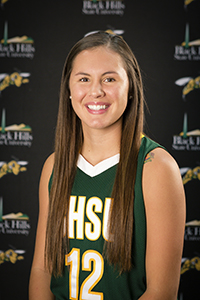College of Business and Natural Sciences
Students
Events
Sanford
Athletics
Academic Affairs
BHSU student athlete participates in groundbreaking research

The research was part of the Germanium Materials and Detectors Advancement Research Consortium (GEMADARC) undergraduate research experience.
The GEMADARC project holds a global partnership of 11 institutions across five countries including Canada, China, Taiwan, Germany, and the U.S. Their mission is to advance knowledge, research and discovery in fundamental physics, provide opportunities for undergraduate STEM majors, and to improve global collaboration on Germanium-related technology.
Dr. Urla Marcus, director of American Indian Studies at BHSU, urged Davis to apply for the project. A little hesitant, Davis applied and was accepted. She explains, “I thought it would give me a chance to broaden my knowledge in the science field. My group’s research activity was measuring the radioactivity of different sources.”
Other BHSU students that participated this year were Cortez Standing Bear, biology major from Aberdeen; Erika Redinger, physical science major from St. Onge, and Tada Vargas of Oglala Lakota College.
As a part of the project, Davis spent 15 days in Europe. The students went to the underground physics lab Grand Sasso National Laboratory in central Italy. They also participated in research at the Sanford Underground Research Facility in Lead.
Davis explains, “Our GEMADARC project included learning about radioactivity and taking measurements on sources. A germanium detector was used at the underground facility in Lead to measure radioactivity. We surrounded it with lead block to limit radioactive substances in our surroundings.”
Davis hopes to attend graduate school for occupational therapy after graduating with her bachelors. Eventually, she wants to go back to a reservation for work. “My overall goal is to help Native American people in any way I can,” she adds. With her passion for sports, she also hopes to coach volleyball or basketball.
Balancing academics, sports, and extracurriculars is no easy feat. First and foremost, academics come first, Davis says. “Some days are harder than others, but I try to stay motivated every day.” A good night of rest and keeping a planner are Davis’ two pieces of advice for balancing the opportunities available in college.
About Exercise Science at BHSU
The Exercise Science program at BHSU prepares students for work in health and exercise related fields. Students work with professor who have outstanding expertise and experience.
Graduates of the program are prepared to enter a variety of fields related to exercise physiology, cardiac rehabilitation, strength and conditioning, and personal training. In addition, graduates are prepared for advanced study in the fields of physical therapy, occupational therapy, athletic training, exercise physiology, chiropractic, nursing, and physician assistants. Many go into graduate programs to become highly specialized. To learn more, visit www.BHSU.edu/ExerciseScience or contact Dr. Craig Triplett, assistant professor of exercise science, 605-642-6169 or Craig.Triplett@BHSU.edu
About Physics at BHSU
The Physical Science degree at Black Hills State University is dedicated to its students by giving them enriching research opportunities. BHSU is establishing a nuclear and particle astrophysics program that studies the very smallest particles in the universe in order to understand structures as large as stars, supernova and even galaxies. The Sanford Underground Research Facility in Lead, SD acts as a perfect location to study these particles. There are many exciting experiments and centers to get involved in at BHSU such as the ongoing research in the Optics Lab, CUBED, FAARM, and QuarkNet.
Learn more about the program by going to www.BHSU.edu/Physics or contact Dr. Kara Keeter at 605-642-6026 or Kara.Keeter@BHSU.edu
Physics at Black Hills State University is a subdivision of the School of Natural Sciences that includes Biology, Chemistry and Physical Science. The close association of all of these disciplines in a single department makes for a vibrant scientific community with strong interdisciplinary interactions. Physics plays a key role in the Environmental Physical Science and Physical Science programs.

